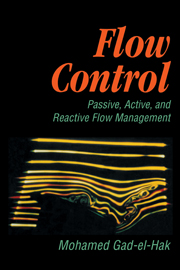Book contents
- Frontmatter
- Contents
- Preface
- Nomenclature
- 1 Introduction
- 2 Governing Equations
- 3 Unifying Principles
- 4 Coherent Structures
- 5 Reynolds Number Effects
- 6 Transition Control
- 7 Compliant Coatings
- 8 Separation Control
- 9 Low-Reynolds-Number Aerodynamics
- 10 Drag Reduction
- 11 Mixing Enhancement
- 12 Noise Reduction
- 13 Microelectromechanical Systems
- 14 Frontiers of Flow Control
- Epilogue
- Bibliography
- Index
6 - Transition Control
Published online by Cambridge University Press: 23 December 2009
- Frontmatter
- Contents
- Preface
- Nomenclature
- 1 Introduction
- 2 Governing Equations
- 3 Unifying Principles
- 4 Coherent Structures
- 5 Reynolds Number Effects
- 6 Transition Control
- 7 Compliant Coatings
- 8 Separation Control
- 9 Low-Reynolds-Number Aerodynamics
- 10 Drag Reduction
- 11 Mixing Enhancement
- 12 Noise Reduction
- 13 Microelectromechanical Systems
- 14 Frontiers of Flow Control
- Epilogue
- Bibliography
- Index
Summary
I have no special talents. I am only passionately curious.
(Albert Einstein, 1879–1955)That is the essence of science: ask an impertinent question, and you are on the way to a pertinent answer.
(Jacob Bronowski, 1908–1974)PROLOGUE
Delaying laminar-to-turbulence transition of a boundary layer has many obvious advantages. Depending on the Reynolds number, the skin-friction drag in the laminar state can be as much as an order of magnitude less than that in the turbulent condition (Figure 6.1). For an aircraft or an underwater body, the reduced drag means longer range, reduced fuel cost and volume, or increased speed. Flow-induced noise results from the pressure fluctuations in the turbulent boundary layer and, hence, is virtually nonexistent in the laminar case. Reducing the boundary layer noise is crucial to the proper operation of an underwater sonar. On the other hand, turbulence is an efficient mixer, and rates of mass, momentum, and heat transfer are much lower in the laminar state; thus, early transition may be sought in some applications as, for example, when enhanced heat transfer rates are desired in heat exchangers or when rapid mixing is needed in combustors. This chapter focuses on transition delay, particularly for wall-bounded flows. Transition advancement will be discussed in Chapter 11.
Free-Shear versus Wall-Bounded Flows
Free-shear flows, such as jets, wakes, and mixing layers, are characterized by in- flectional mean-velocity profiles and are therefore susceptible to inviscid instabilities.
- Type
- Chapter
- Information
- Flow ControlPassive, Active, and Reactive Flow Management, pp. 104 - 119Publisher: Cambridge University PressPrint publication year: 2000
- 2
- Cited by

